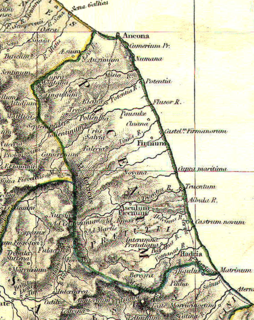
The gens Rabiria was a minor plebeian family at Ancient Rome. Although of senatorial rank, few members of this gens appear in history, and the only one known to have held any of the higher offices of the Roman state was Gaius Rabirius Postumus, who was praetor circa 48 or 47 BC.
The gens Artoria was a minor plebeian family at ancient Rome. Few members of this gens are mentioned in history, but a number are known from inscriptions. Under the later Empire at least some of them were of senatorial rank.
The gens Afrania was a plebeian family at Rome, which is first mentioned in the second century BC. The first member of this gens to achieve prominence was Gaius Afranius Stellio, who became praetor in 185 BC.
The gens Accia was a Roman family during the late Republic. The gens is known primarily from two individuals, Lucius Accius, a tragic poet of the second century BC, and Titus Accius, best known for his prosecution of Aulus Cluentius Habitus in Cicero's oration Pro Cluentio. Other Accii are known from inscriptions.
The gens Acutia was a minor plebeian family at Ancient Rome. Members of this gens are mentioned from the early Republic to imperial times. The first of the Acutii to achieve prominence was Marcus Acutius, tribune of the plebs in 401 BC.
The gens Coruncania was a plebeian family at Rome. The first of the family to come to prominence was Tiberius Coruncanius, a novus homo who became consul in 280 BC, and dictator in 246.
The gens Orbia was a minor plebeian family at Rome. No members of this gens are known to have held any magistracies, but many of them are known from inscriptions. The most illustrious of the family may have been the jurist Publius Orbius, a contemporary of Cicero.
The gens Ostoria, occasionally written Hostoria, was a plebeian family at Rome. Members of this gens are first mentioned in the early years of the Empire. Although only a few of them achieved any prominence in the Roman state, many others are known from inscriptions. The most illustrious of the Ostorii was probably Publius Ostorius Scapula, who was consul during the reign of Claudius, and afterward governor of Britain.

The gens Petillia or Petilia was a plebeian family at ancient Rome. Members of this gens first appear in history at the beginning of the second century BC, and the first to obtain the consulship was Quintus Petillius Spurinus in 176 BC.
The gens Pinnia was an obscure plebeian family at ancient Rome. Few members of this gens are mentioned in history, and few of them attained any of the higher offices of the Roman state, although a few became local governors, and at least one, Lucius Pinnius Porphyrio, held the quaestorship. Many others are known from inscriptions.
The gens Plinia was a plebeian family at ancient Rome. Few members of this gens are mentioned in history, and the Plinii are best known from the scholar and antiquarian, Gaius Plinius Secundus, author of the Historia Naturalis, who lived during the first century AD.
The gens Pollia was a minor plebeian family at ancient Rome. The gens must have been very old, as one of the original Servian tribes was named after it, suggesting that the Pollii were important landowners during the Roman monarchy. However, few Pollii are mentioned in history, and none of them attained any of the higher offices of the Roman state. A number of Pollii are known from inscriptions.
The gens Praecilia or Precilia, also written as Praecillia or Precillia, was an obscure plebeian family at ancient Rome. Few members of this gens are mentioned in history, but a number are known from inscriptions.
The gens Romania was an obscure plebeian family at ancient Rome. No members of this gens appear in history, but many are known from inscriptions.
The gens Rullia was an obscure plebeian family at ancient Rome. No members of this gens are mentioned in history, but a number are known from inscriptions.
The gens Rusticelia, occasionally spelled Rusticellia, was an obscure plebeian family at ancient Rome. Hardly any members of this gens are mentioned in ancient writers, but a number are known from inscriptions.
The gens Safinia was a minor plebeian family at ancient Rome. Few members of this gens are mentioned in history, but a number are known from inscriptions.
The gens Sammia or Samia was an obscure plebeian family of equestrian rank at ancient Rome. Few members of this gens are mentioned in history, but a number are known from inscriptions.
The gens Satellia was an obscure plebeian family of equestrian rank at ancient Rome. Few members of this gens are mentioned in ancient writers, but a number are known from inscriptions.
The gens Selicia, possibly identical with Silicia, was an obscure plebeian family at ancient Rome. Hardly any members of this gens are mentioned in history, but a number are known from inscriptions.









